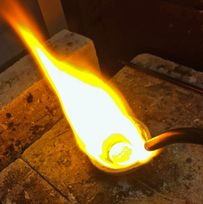 Alchemy and other mysteries I remember back before I was a jewelry/metals student, hearing about rare rose and white gold from the Black Hills. So confusing, because I knew gold was yellow, so how did some of it get to be rose colored? And of course I knew gold was soft, because on TV everyone was always biting a gold coin to see if it was real! So why isn't gold jewelry that soft? And what is all this business with 14 karats and 18 karats? I've puzzled out the answers to those and many more questions about gold over the years, so I thought it would be fun to share a bit about what I've learned. First off, yes pure gold is yellow and very soft, way too soft for jewelry. Another way to say pure gold is to say 24 karat gold, or 24K. The karat is the measure of purity, so 24/24 = 100% pure. (Why 24 parts and not 25 or 10? No idea, sorry!) In order to create a gold alloy that is strong enough for jewelry and less expensive, it is alloyed with other metals. For instance, 18k yellow gold is 75% pure gold, and 25% base metals (that 25% is generally equal parts silver and copper to keep the color neutral). 18/24 = 75%. Bonus fact: in many countries, 18k gold is marked 750.  Rose, white, peach and green! So the non-yellow golds are created by adding different colored metals to the alloy. That is why colored golds are often 14K, to allow for more color development. 14/24 = 58% gold, 42% other metal. If the other metal is all copper, you get rose gold. If the other metal is all palladium or nickel, you get white gold. Odd color golds like peach and green are other combinations of silver, copper, and nickel or palladium. Each gold refiner and even time period has its own special 'recipe' for the alloy, causing slight variations even within one color and karat combination (not all 18k yellow is the same yellow, for instance - vintage yellow gold tends to be rosier). Of course each karat and color combination has its own working characteristics - melting temp, hardness, ductility, etc. Bonus fact: nickel white gold is banned in Europe, as they've determined nickel causes skin allergies and may be carcinogenic. That is one reason I only use palladium in my white gold. It is really fun to alloy your own colored golds - just takes some math, a scale, some borax, a clean crucible and a torch. Oh, and something to pour that gold into! Many goldsmiths prefer to order their gold in 24k form, and always alloy it themselves. I do that occasionally, but prefer the convenience of ordering the karat, color and shape that is close to what I need. So the non-yellow golds are created by adding different colored metals to the alloy. That is why colored golds are often 14K, to allow for richer color development. 14/24 = 58% gold, 42% other metal. If the other metal is all copper, you get rose gold. If the other metal is all palladium or nickel, you get white gold. Odd color golds like peach and green are usually combinations of silver, copper, and nickel or palladium. Of course each karat and color combination has its own working characteristics - melting temp, hardness, ductility, etc. It is really fun to alloy your own colored golds - just takes some math, a scale, some borax, a clean crucible and a torch. Oh, and something to pour that gold into! Many goldsmiths prefer to order their gold in 24k form, and always alloy it themselves. I do that occasionally, but prefer the convenience of ordering the karat, color and shape that is close to what I need.  So, what about that carat? Spelling is important here, because a carat is another thing entirely - a unit of weight for measuring precious stones, often diamonds. One carat = 200 milligrams. A round one carat diamond is about 6.4mm in diameter.
2 Comments
Luise Sellier
4/26/2015 09:05:45 am
Thanks! Always interesting learning from you! You are a great teacher!
Reply
Alex Gage
4/27/2015 02:54:18 am
Thanks Ann very helpful
Reply
Your comment will be posted after it is approved.
Leave a Reply. |
Anne WolfEducator, metalsmith, jeweler, maker of custom mokume gane jewelry and wedding rings.
Archives
July 2024
|
Home | Rings | Classes | About | Blog | Shop my Etsy Store | Contact | Policies | Join My Mailing List
Top quality, hand-crafted custom mokume gane wedding rings, jewelry and expert mokume gane instruction.
2750 Historic Decatur Road Studio 209 in Barracks 15 San Diego, CA 92106
619-488-7540
2750 Historic Decatur Road Studio 209 in Barracks 15 San Diego, CA 92106
619-488-7540
©2005-2019 Anneville Studio and Jewelry Lab. All rights reserved. 🔨

 RSS Feed
RSS Feed